
Here it is as promised, the continuation of my previous article about Bug Photographywhere I showcase some of my photos and deliver my fellow readers some fun facts about them.
Scrolling through my old photos it´s amazing to see how diverse the insect/arachnid world is and I somehow managed to capture them perfectly since capturing them is not an easy task.
Disclaimer: if you have any bug related phobias reader discretion is advised
So, without further ado, here are the results of my "bug safari".
1. Bumblebee

Living in the coastal area one very common plant I see is the Hottentot-fig plant (Carpobrotus edulis) A species of succulent with these colorful flowers. The irony is that this a non-native species, going so far as to be invasive in some regions.
But on the other hand, it is an attractive plant for some pollinators such as the cute Bumblebee (Bombus terrestris), I caught a glimpse of these guys on Naturconde, Vila Do Conde, Portugal.

While often mistaken for honey bees, these fluffy bugs have a similar social structure, with a queen, female workers, and of course, drones and forage for pollen and nectar. However, unlike honey bees, they do no make honey.
Another difference is their bigger furry bodies. Their name itself comes from their bumbling flight.
Best season to see them? The best time season to see them is during summer and spring.
2.Diptera
Diptera is known to be the order to which insects like flies and mosquitos belong to. While these two are the first thing that comes to mind when talking about this order, in reality, they occupy other niches besides just beings a pest, such as this hoverfly of the Syrphidae family.

Funny enough, I did not what it was when it first landed on my hand at a beach in Póvoa de Varzim, it had the color of a wasp but the shape is different.
They're named after their habit of being seen hovering midair or over flowers. While the adults feed on nectar, their larvae are carnivorous, preying on plant-sucking insects like aphids, making them a great tool for pest control.
While harmless, it is believed their yellow and black color serves as a deterrent to predators.
And to think I didn´t know they existed before one landed on me.

Next up is a photo of a Robberfly from the ** Asilidae** family. These guys are full-on predators, they´re really good when it comes to hunting flying bugs, while they prefer to capture smaller prey, they can sometimes be found going after bigger ones. They're the Eagles among flies.
You can easily recognize them by their long abdomens, a mystax composed of stiff hair that looks like a mustache (protecting them from struggling prey), elevated eyes, and a proboscis which they use to inject a concoction of neurotoxins and enzymes, which kills their food.
Don´t worry, despite their intimidating appearance, they´re harmless to humans.

This just your typical house fly. They can sometimes act as pollinators too, who knew. Mind you, this was an early attempt of using a macro lens.

And I managed to find these in the same place I found the bumblebees, it was a warm summer-like day, and since the plants were in bloom they attracted a lot of insects. I plan to share the rest of my findings that day in a future article.
3. Lepidoptera
Ah, yes the order of butterflies and moths one of the most charismatic groups of insects.
Despite being similar they are only a couple of differences, for example, moths unlike butterflies rest with their wings open, they have furry bodies, mostly nocturnal (though there are exceptions), have a leaf-like shape for their antenna. day and all the plants seem to attract a large variety of insects.

Now there is some stigma that moths are uglier than butterflies which is not true. Some can be colorful and even cute looking such as this orange moth that I captured in Mindelo, Vila Do Conde, it´s probably from the genus Mythimna, but I have yet to confirm this.

In the same area, I also found this cool-looking caterpillar, chewing its way out of a plant on the dunes. I think it might belong to the same species as this moth. But hey, it looks cool.
In this next photo is a **Geranium bronze ** (Cacyreus marshalli) that is I identified it correctly.
I think it might be a female, since males are mostly blue, while females are duller with only a bit of blue at the center.
The underside of their wings is brown with a bunch of white markings and small eyespots on the tip. Fun fact, this is not a native species but a gardener invader native to South Africa and introduced in the 20 century, spreading out to European Mediterranean regions and the UK.
It loves to attack cultivated Pelargonium and Geranium plants, but the issue is less with the adults, but more to do with the larvae who feed off the buds, young leaves, and burrow into the stems. The larvae can be green or yellow with pink markings. So, look out for these guys if you have these plants in your home.

And last but not least this small common moth resting in my window enjoying the sun´s rays. Forgive me, I don´t know the identification of this one, but I thought it looked neat and wanted to see I could get a decent picture of it against the glass. I think I did okay despite using a smartphone.
And That´s It For Now.
I hope you all enjoy this article and learning a bit more about the bug world. If you happen to have any questions, noticed I made a mistake or wanna help me identify some of the unknown species, feel free to comment below. Feedback is always welcome.
Thanks for reading, if you like my content feel free to tip me here or you can follow me on other sites through Cointr.ee
references:
https://en.wikipedia.org/wiki/Housefly
https://www.colorado.edu/asmagazine/2020/02/28/robber-flies-are-fierce-predators-and-resourceful-lovers
https://en.wikipedia.org/wiki/Hoverfly
https://en.wikipedia.org/wiki/Bombus_terrestris
https://australianbutterflies.com/8-differences-between-butterflies-and-moths/
https://www.inaturalist.org/taxa/119664-Cacyreus-marshalli
